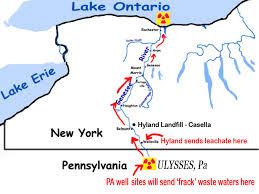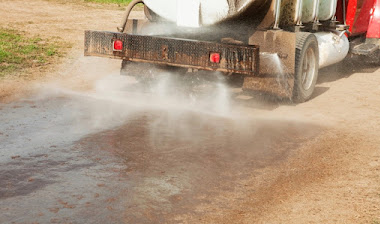Jerusalem Sung To Honour Those Harmed in PA by Fracking
August 12, 2013Fracking Boom Could Lead to Housing Bust
August 18, 2013By Peter Mantius, DC Bureau, August 14, 2013
Questions about the integrity of official water tests are stirring the latest controversy over New York State’s embattled policy of allowing imports of radioactive waste from natural gas drilling operations in Pennsylvania.
The issue arose last month in Casella Waste Systems’ bid to speed up by 49 percent deliveries to its Hyland Landfill in Angelica, about 80 miles south of Rochester. Neighbors of the landfill and the Sierra Club are asking the state to conduct a full environmental review of the case or at least to hold a public hearing on it. So far, the state Department of Environmental Conservation has not responded to those requests. “We are currently reviewing the comments received on the Casella solid waste application, and no decisions have been made,” said Lisa King, a DEC public information officer.
Meanwhile, water testing data related to Hyland and a wastewater treatment plant that accepts its leachate have been linked to a Syracuse laboratory that pled guilty in July to one felony count of mail fraud in a case said to involve 3,300 falsified water tests.
Federal prosecutors and the DEC have so far declined to provide details of the faked tests. But documents obtained by DCBureau confirm that the guilty company, Upstate Laboratories Inc., analyzed material from Hyland as recently as this past February. “It doesn’t allay our concerns that these guys have been dealing with a crooked lab,” said Gary Abraham, an attorney for Concerned Citizens of Allegany County, a group opposing Hyland’s latest permit bid.
The permit application is the last chapter in a long-simmering controversy over the DEC’s narrow interpretation of its responsibility to monitor radioactive waste. That legal stance has opened the door for imports of waste from horizontal hydraulic fracturing, or fracking, of the Marcellus shale in Pennsylvania.
Most shale formations contain naturally occurring radioactive material, or NORM. Although contamination levels vary widely from well to well, the Marcellus formation is suspected to be the most radioactive of all the nation’s shales.
The brine, rock cuttings and drilling mud from Marcellus wells are likely to contain heightened levels of radium isotopes, including Radium 226, which is especially dangerous because it is soluble in water. Earlier this year, state regulators in Pennsylvania launched a study of radioactivity in Marcellus drilling waste, giving drillers in that state further incentive to find dumping options across the New York border. New York has not conducted or planned a similar study.
State Sen. Cecilia Tkaczyk says New York’s approach to importing fracking waste is illogical, given that the state doesn’t even allow horizontal fracking in its Marcellus shale due to health and environmental concerns. “If we don’t allow fracking in New York due to its environmental downsides, why do we accept fracking waste products from other states?” said Tkaczyk. She has introduced legislation to ban fracking waste imports from other states.
Sen. Terry Gipson, who like Tkaczyk represents a district that abuts the Hudson River, has a similar bill. Both are Democrats in a Republican-controlled body that has blocked virtually every piece of legislation opposed by gas drillers. But their activities show the DEC’s policy on radioactivity is drawing statewide attention.
The DEC is known to allow Hyland and four other upstate New York landfills to accept out-of-state drilling wastes, even though none has a license to handle radioactive materials — either high-level or low-level.
Other New York landfills might be waste importers as well, Abraham said, given Casella’s history of accepting waste streams that exceed its permitted authority and then obtaining retroactive approval from the DEC.
Officially, the DEC allows Pennsylvania drilling waste at Hyland in Angelica, the Hakes Landfill in Painted Post, the Chemung Landfill near Elmira, Seneca Meadows Landfill in Waterloo and the Allied/BFI Waste Systems landfill in Niagara Falls. The agency argues that it is not authorized to regulate NORM unless it has been “processed and concentrated,” a phrase it interprets narrowly.
DEC officials took that stance in a 2010 legal challenge to Casella’s plan to expand the Casella-operated Chemung Landfill in order to make room for more drill cuttings from Pennsylvania. In that case, the DEC argued that since the cuttings were not subject to state regulation, the level of their radioactive contamination was legally irrelevant to the application to expand the landfill. The agency’s position dovetailed with the arguments of Casella’s lawyer, Tom West, an Albany attorney who conducts extensive business with the DEC.
Casella had started importing radioactive drill cuttings at Chemung months before notifying the DEC. The company had also accepted soil contaminated by spills, a waste category not permitted under its permit, Abraham said. But with West’s help, it won retroactive approval of both activities.
West has a record of influence at the DEC. He has taken credit for drafting New York’s 2005 “compulsory integration” law, which forces homeowners to accept gas drilling under their homes. The DEC endorsed West’s bill and helped it slide through the legislative session without hearings. At the time, he represented Chesapeake, a major driller.
West has continued to maintain exceptional access to DEC leaders. In 2011, when the DEC was revising its supplemental generic environmental impact statement for horizontal fracking in New York, the agency let West peak at its early drafts before they were made public. In response, he sent an email to DEC’s executive deputy commissioner and its general counsel urging the agency to “reduce or eliminate radionuclide testing.”
Also, Tony Ingraffea, a Cornell University professor, and other expert witnesses challenged the DEC’s assertion that drill cuttings are not “processed and concentrated.” But a DEC administrative law judge, Edward Buhrmaster, struck Ingraffea’s testimony from the record. In September 2010 he sided with West and the DEC staff in ruling contamination levels irrelevant. No higher court has reviewed his decision.
A month after Buhrmaster’s ruling in Chemung, Casella began accepting out-of-state drill cuttings at the Hyland Landfill 80 miles to the west. Casella owns that facility. In 2012, the DEC modified Hyland’s operating permit to allow it to accept drilling sludges and residuals from recycling or treatment of produced water and fracking fluids, materials in which radioactive materials tend to concentrate.
When the DEC conducted tests of brine from New York’s 12 vertical Marcellus wells in 2009, it found readings for Radium 226 as high as 16,030 picocuries per liter, more than 3,000 times the legal limit for drinking water and several hundred times the legal limit for discharge into the environment.
“Considering that Hyland is permitted to accept Marcellus Shale industry wastewater solidified to 20 percent solids — thus, 80 percent liquid — substantial volumes of liquid saturated with Radium 226 could be disposed in the landfill,” Abraham wrote last month to the DEC’s Mary E. Hohmann.
 Those radium-saturated liquids are a threat to seep into the leachate that the landfill ships to water treatment plants in Wellsville and Bath, which are not equipped to remove radioactive materials. They dump their effluents into the Genesee and Cohocton rivers, respectively.
Those radium-saturated liquids are a threat to seep into the leachate that the landfill ships to water treatment plants in Wellsville and Bath, which are not equipped to remove radioactive materials. They dump their effluents into the Genesee and Cohocton rivers, respectively.
Early this year, officials in the Village of Wellsville displayed concern about the potential toxicity of the leachate its water treatment plant was accepting from Hyland. In a Jan. 9, 2013 letter to Hyland, the town agreed to continue accepting the waste from the landfill for the rest of the year if and only if Hyland agreed to indemnify the village and its officers from liability from any unexpected legal consequences. Since then, missing documentation on the toxicity of effluent from the Wellsville treatment plant threatens to stall or derail its updated State Pollution Discharge Elimination System permit for releases into the Genesee River.
In April, the federal Environmental Protection Agency prohibited the DEC from issuing Hyland its updated SPDES permit until it shows the EPA the necessary data. The EPA said last week it had not received a response from the DEC. The missing data may have been produced by Upstate Laboratories, the guilty Syracuse water lab, based on a press release issued July 17 by the U.S. Attorney in Syracuse. The PR statement contained a list of 31 clients of Upstate, one of which was “Casella Waste Systems via On-Site Technical Services in Wellsville.”
Joseph Boyles, Casella’s general manager at Hyland, referred questions about his landfill’s relationship with Upstate to Carla Jordan, a Casella compliance officer. Ms. Jordan did not return phone calls.
While federal and state officials have declined to specify whether Upstate handled recent testing for the Wellsville wastewater plant, the guilty firm definitely did analyze leachate flows in and effluent flows out of Steuben’s leachate treatment in Bath earlier this year, documents show. The Bath facility accepted more than 2.2 million gallons of leachate from Hyland between July 2012 and April 2013. It also took in roughly the same volume from Casella’s Hakes Landfill, which also accepts drilling waste from Pennsylvania, and 1 million gallons from the Ontario County Landfill, which Casella operates near Geneva. Ontario is not a drilling waste importer, at least officially.
DCBureau.org obtained a copy of influent and effluent data for Steuben County’s Bath treatment facility for February 2013 that shows it was analyzed by Upstate Laboratories. Steuben had remained loyal to the Syracuse lab despite its mounting regulatory and legal problems:
- In September 2010, Upstate’s offices and lab facilities were raided by EPA inspectors and armed federal investigators in bullet-proof vests.
- In December 2011, the New York State Department of Health conducted a series of unannounced exams at the lab.
- On Feb. 27, 2012, the Health Department suspended Upstate’s lab certification and barred it from jobs involving the state DOH. It’s not clear whether other regulators, including the DEC and the EPA, responded to the DOH action with steps of their own.
- Finally, on March 7, 2013 — more than a year after DOH suspended its certification — Upstate sent a form letter to its “valued clients” informing them that it was “no longer a certified laboratory in New York State.”
Within a day or two Steuben County and other clients cancelled their Upstate contracts.
In a March 7 email, Steve Orcutt of the Steuben County Public Works Department wrote: “I sent (Upstate Laboratories Inc.) a termination letter today… In light of what’s going on w/ ULI, as a precaution, I want to resample what they (picked up) on 3/5 and send to another lab.”




